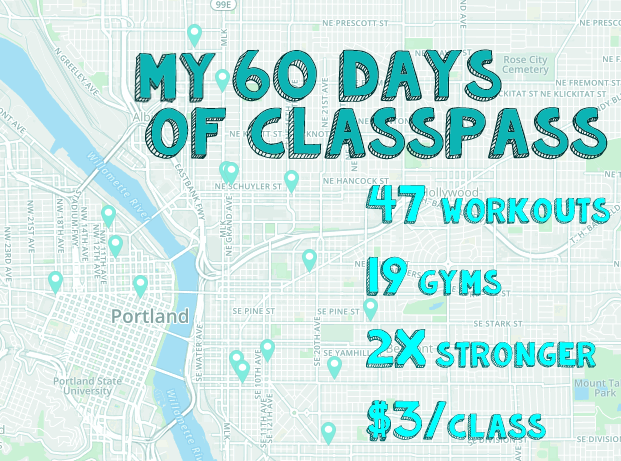My usual fitness plan consists of using the Big Blue Gym (running, biking outside) and telling myself that I’ll start stretching regularly tomorrow. I’m cheap – the idea of paying to work out when I already pay for roads and sidewalks and parks has always seemed ridiculous. Since I stopped figure skating competitively 11 years ago, my fitness levels have waxed and waned almost directly proportional to the length of my bike commute and available daylight hours.
The Big Blue Gym fitness plan was working pretty well until I got officially into my late 20’s; no longer can I smother a large platter of tater tots in hot sauce for dinner and simply ride to work and be in great shape.* It doesn’t help that my round trip commute is now only 4 miles.
This December was my worst fitness month in recent history. I averaged just 6.38 miles a day of bike riding and only ran 8 miles the entire month. I drank an average of 2 alcoholic drinks a day and was clocking 68 hours a week at the office and still took home work every night. I gave up and ate boxed vegan mac and cheese at least twice a week.

Once January hit and my crazy season ended at work, I realized it was time to try Something Very New. The Big Blue Gym had turned into The Dark Rainy Gray Gym and I was not getting fit. January lined up pretty well with all the gyms having their new year’s resolution sales, and I thought I’d try out Classpass when it was on sale for $20 for 2 weeks. I thought I’d cancel after that, but it was worth a jumpstart.
8 weeks later, Classpass has made me: measurably stronger (I can deadlift 80% of my bodyweight now), drink less (I halved my average drinks per day), stretch every single day, and a generally more daring person.
I’ve gone to 19 different gyms and taken 47 hour+ long fitness classes. I’ve done barre, olympic weightlifting, and contemporary dance.
What exactly is Classpass? It’s a subscription service that gives access to a network of high-end “boutique” fitness classes. For $79/month, you can go to as many yoga, spinning, and crossfit classes in the studio that your heart desires. The kind of fitness studios that are in this are the kind of brand name places where classes usually run $11-20 a pop. There’s a few caveats though: you can only go to 3 classes at each gym per month, class schedules are only available a week out, and you can only have 4 classes booked at a time.
The Pros of Classpass

- Just Tell Me What to Do
The biggest advantage of going to group fitness classes over solo working out is that I don’t have to think. Instead of having to spend brain power on figuring out how much time should be spent stretching or how many reps is enough, a professional tells me. It’s not that I can’t figure this out on my own – I can, I have the coaching background (figure skating) and Google – but with a group class, I don’t have to worry about it.
The less time I have to spend figuring out the right rep progression, the more time I can spend actually working out. Even when I was a competitive athlete, during solo training I spent a lot of time crafting training plans or skating around in circles thinking about the next jump to work on. With classes instead of solo training, simply getting myself to the gym is the only thing I need to do to make sure I get a successful hour of working out. No longer do I have to worry about which heavy things to lift when or how hard I need to go to hit the maximal aerobic capacity. Someone else worries about that for me, I just do it.
- Accountability
This is the key for why Classpass is working for me more than a traditional DIY gym. I have to not only commit to working out, I have to commit to a time and a place. I have to make a conscience decision to work out, and what type of workout to do. Research shows that writing down a concrete time and place makes you more likely to achieve your goal. Classes work because I have to put them on my calendar. And the kicker: if I cancel or flake less than 12 hours before class, Classpass charges me $20. On the contrary, my neighborhood park won’t charge me $20 if I don’t go on that 6AM run I said I would. My commitment to a workout changes for the better when there’s money on the line.** $20 is a lot to pay to sleep in an extra hour just because I don’t want to go stretch.
The group class format has other accountability perks: just having other people around means I work harder. Alone in the park at 6AM, I might stop and walk if I get a bit tired, in a group class, I feel the pressure of everyone else working alongside me and I don’t slack. Peer pressure works. - Variety
It turns out, just running is pretty boring. So is just biking. Even with access to the wealth of options in a traditional DIY gym, I end up doing the same thing over and over again because I know how to do it correctly. Classpass has a bazillion different options and because you’re limited to 3 classes at each studio/month, there’s an incentive to try a variety. And if you hate it, well, that’s no cost to you. I now do olympic weightlifting, Barre classes, Crossfit and even something called “Pil-oga-Robic”. (I never would’ve tried something with that silly name before. In fact, I’ve worked 2 blocks away for over a year and I never gave it a second thought until it was on Classpass.) Not only do I get variety in type of exercise, I get variety in type of studio. Wednesday morning I might go to grimy little lifting gym in industrial SE, Friday afternoon I’ll be laying on my back and having end-of-class aromatherapy rubbed on my temples at a beautiful pilates studio in Irvington. - More working out = less booze
Exercise is a great substitute for a one-glass-of-whiskey-after-work habit. Instead of swinging by happy hour after work, I swing by a fancy gym and “treat myself” to lunges and deadlifts instead of manhattans. My average daily drinks of alcohol have dropped by 50% since I started working out. Perhaps because of the feel-good endorphins, perhaps because a 5:30PM class means I get home an hour later and have less time to pour myself a drink before dinner. - Stretching my Comfort Level More Often
Talking to strangers. Doing new things. These are good skills, especially for a fundraiser. As a natural introvert, I often cling to the wall or punch bowl at parties where I don’t know anyone. Trying out new gyms & classes forces me to engage in conversations with strangers regularly. Each time I get to improve my “pitch” and try out new tactics for asking people about themselves. Something about trying out small talk while you’re also grunting and lifting an 85 pound barbell lessens the pressure to be perfect. Just like regular muscles, the meeting-people muscle gets stronger each time you exercise it. - No more schedule excuses
As someone with a constantly shifting schedule of morning coffee meetings and evening committees, being locked into a single gym’s class offerings meant that if there wasn’t a class available at a time I could go, I often just wouldn’t hit the gym that day. This was especially problematic when I was working 5 jobs at off-peak times (try finding a gym that has classes at 4:30AM and 10:30AM).
Plenty of advice on creating good fitness habits recommends setting aside a sacrosanct “exercise time” each day that you won’t move for anything. I live and work in a reality where that’s pretty much impossible. Donors and board members are busy people with day jobs- I need to be available when they are. Solution to that? Classpass. With a huge network of fitness classes, I can almost always find a class that fits into my schedule on a given day. If I commit to working out every day, Classpass means I have to find “a time that works that day” instead of “the time that works everyday”. - Raising the Bar
If I were to go to a high-end “boutique” gym like Barre3 or Studio X on my own, $79/month would get me about 2 classes a week (these classes usually run $10-20 each) Because the classes are unlimited with Classpass, it forces me to raise the bar on what I can do in a week. Instead of being limited by budget, I end up seeing how far I can push it- just how low per-class can I get the marginal cost? (Last month it was $3 a class).
The Cons of Classpass

- The Double-Edged Sword of Variety
While you can easily put together a comprehensive exercise routine from Classpass (I alternate between cardio/stretching like Barre and Weightlifting/HIIT), the variety means you can’t get really good at one specific type of exercise method. While alternating workouts has made me a stronger person overall (and bendier), I’ll never be a “rockstar” at The Bar Method or have my photo on the wall at a lifting gym. It’s good for overall fitness, but not specific skillsets. - Loyalty
I’m a Hufflepuff. I value loyalty – and classpass simply doesn’t allow that. With a limit of 3 classes/month at any one studio, I’ll never be a regular anywhere. It means I don’t build necessarily meaningful relationships with an individual gym community. Some gyms have days where they take measurements and do fitness assessments for their clients, and with Classpass, you just miss out on that. I also feel a little guilty since I know the gyms get less cash for each class than they would if I paid them directly. - Sometimes decisions are hard
I love group exercise classes because I have to make less decisions when I’m working out, but with Classpass I often end up having to make more decisions about my workout. If I just had one gym, the decision would mostly be “what time should I go?” But with Classpass, I’m not only weighing where I should go, I’m weighing what time, if that gym has a shower or if I’ll need to swing home, and what type of workout I want on that particular day. There’s been a few times where I’ve been back and forth over and over about whether I should go to a specific class or gym and the decision takes way too much brainpower. - The Class You Want Where You Want It Isn’t Always Available
Individual gyms are allowed to limit which type of classes and which schedules they have available to classpass members. That means that sometimes I *really* want to go to a 6AM Barre3 class in SE, but only the N Williams location is available at that time. Or I’d like to weightlift near my house on Friday, but I already used up my 3 credits for that month at that gym. The class times are also limited to times when instructors want to teach – if I want to go to the gym at 6AM on Sunday or 10:30PM, there’s nothing available. Compared to a 24-hour-gym, there’s not as much flexibility. - More expensive than a traditional gym or the Big Blue Gym
There’s a gym a few miles from my house that’s open 24 hours a day and is $25/month. Classpass is easily double the monthly cost a traditional bargain gym membership and much, much more expensive than running outside. Every month, I definitely feel that $79 leave my pocket – that’s more than half of my monthly grocery budget, and ends up being my #3 biggest expense each month after rent and groceries. - It’s hard to get into a “routine”
This is another double-edged sword. Instead of going to the same place every morning at 6AM and getting it ingrained, I had to get into the habit of going “somewhere” every day instead of “specifically to one place” every morning. Definitely not the best habit-forming practice.
For now, I’m going to stick with Classpass. If the studios I like stop offering classes or if I need to trim my budget quickly, I’ll reconsider. What do you think? Does Classpass seems like a good option to you or do you prefer the Big Blue Gym?
If you’re interested in trying out Classpass, you can get 40 bucks off your first month by using this link (and I’ll get $40 off my membership too!) $10 for a month is a pretty good deal for high-end fitness classes.
*I still remember my friend Fool (who is older than me by 8 years or so) shaking his head at 21-year-old me proclaiming “I ride my bike so I can eat whatever I want!” Yes, okay, that hubris caught up with me.
**I use Beeminder to do this in the rest of my life.


From the other side of that story, my gym has been offering Class Pass (it’s 100% class-based, no open gym time). I’ve been going for 2 years, and I really value the relationships I’ve forged and the coaches can give me advice based on knowing me for a long time, and alternately can yell at me when they know I can go harder :)
I wouldn’t say anyone would snub their nose at a class pass person (as many of them end up using it to shop around and then stay with us), but there’s definitely a different dynamic between the regulars and the class pass-ers.
That’s definitely been my feelings a few times. Like I just don’t get to be part of the “in-crowd”. It’s less of an issue at the bigger gyms like Barre3, but small gyms with less than 50 regular clients I really feel the difference. Sometimes I want that. But I also want the mix of classes and Classpass is still a TON cheaper. But I feel guilty regularly about not being part of a “community” at a single gym.
Which gym is yours? Maybe I can try it out on classpass!
Interesting! Thanks for the info- I just need to do something!
I’d be interested in a credit, I keep meaning to make working out more part of my schedule and it just isn’t happening
Sure! I’d do barre, weightlifting, or yoga… The last time I tried to twerk I fell on my face and it was painfully embarrassing. Times?
http://class.ps/d4OWj <— Sign up with this link for the credit, then you can “friend” me and see what classes I’m signed up for!
Here’s one! http://class.ps/d4OWj
Thank you! Do the two weeks kick in when I sign up?
It’s $30 off whichever plan you choose – and one of the plans is a $19 2-week trial so it should come out free plus if you stay on they’ll knock $11 off your first month.
And yea, it usually starts immediately.
Yes!!! I want to 1. Work out more 2. See you more 3. Try class pass. So, 3 out of 3! Let me know if you have any left & we can coordinate schedules.
I do! This link will work! http://class.ps/d4OWj
I SURE FUCKING DO.
Yes please!
Awesome! http://class.ps/d4OWj this should work and then you can friend me! Come do david bowie yoga with me!!!
I work from 2-10 tomorrow! When is it?
here is a link! http://class.ps/d4OWj :-) Maybe you will come to burlesque class in your hood with me sometime! I have a suspicion you would rock at burlesque (or already do)
Me!
Ah damn, it’s at 5PM!
http://class.ps/d4OWj Here! Let me know what classes you hit :-)
Yeah, I work 2-10 Wednesday through Saturday. It’s nice not having to get up early but it sucks for almost everything else!
Aw! What a lovely compliment! I would love to attend burlesque class with you.
Well I usually work out in the mornings :-) Also if you want to do a Sunday class, let me know. I’m taking a twerking class on Sunday :-P
When?!
Because I honestly would love to be able to twerk, not gonna lie.
1PM at 7th and hawthorne! http://www.vmacpdx.com/
(It’s on classpass!)
I CAN MAKE THAT
I’m inspired
My fitness plan relies on free outdoor activities like running and biking, but work stress and shorter commutes have impacted my fitness levels recently.